Six Flags Great America – Gurnee, Illinois
Batman: The Ride
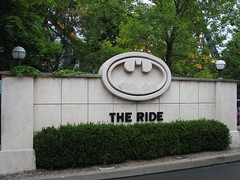 A dialectic runs through my head over whether or not I think Batman is one of B&M’s finest inverted coasters, or simply a scaled-back practice outing that they would later refine and build upon. One part of me (we’ll say it’s my right brain) keeps saying, “Of course it is! This is by far their tightest design ever made for an inverted coaster, back before they became too dependent on force readouts and still made coasters with some kick to them. Everything else after this design was compromised by taller heights and faster speeds… ergo, more controlled forces and slower timing between elements. It might be small and short, but it’s non-stop and packs one of the most aggressive punches Bolliger & Mabillard ever have – or will – pull.”
A dialectic runs through my head over whether or not I think Batman is one of B&M’s finest inverted coasters, or simply a scaled-back practice outing that they would later refine and build upon. One part of me (we’ll say it’s my right brain) keeps saying, “Of course it is! This is by far their tightest design ever made for an inverted coaster, back before they became too dependent on force readouts and still made coasters with some kick to them. Everything else after this design was compromised by taller heights and faster speeds… ergo, more controlled forces and slower timing between elements. It might be small and short, but it’s non-stop and packs one of the most aggressive punches Bolliger & Mabillard ever have – or will – pull.”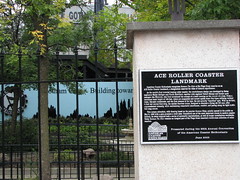
But then the other half of my brain (the left hemisphere) chimes in, “Don’t get too sentimental. While the design of the elements might be tight, that’s only to be canceled out by the extra-small scale and speed. The ride time is short as well, and while it might not be a bad coaster, there are plenty of other inverts built after it that are much more ambitious. The only reason it’s been duplicated so many times is because it’s small, cheap and easily accessible for lazy parks that don’t feel like taking any risks with their design.”
I have more sympathy towards the right hemisphere of my brain, since the left’s argument basically boils down to “bigger is better; clones are bad”, which can easily be defeated.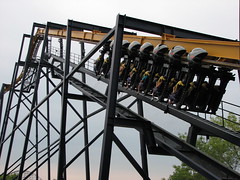 That said, I’ve been on my fair share of Batmen before (Magic Mountain, Over Georgia, Great Adventure, and Illinois’ own original), and out of my one or two rides on each of those park visits I was never able to glean much from those prior experiences, which I would partially attribute to the simple struggle to survive a day in a Six Flags park, with all the long lines and dehydration that normally entails. But I should have a stronger opinion of the coaster by now, so maybe my left brain is correct, and I’m simply transferring my sentimentality for other pre-1998 B&M coasters onto this design. Crowds aren’t too bad, and even still I have a Flash Pass in my pocket, so today should be a good day to settle this debate.
That said, I’ve been on my fair share of Batmen before (Magic Mountain, Over Georgia, Great Adventure, and Illinois’ own original), and out of my one or two rides on each of those park visits I was never able to glean much from those prior experiences, which I would partially attribute to the simple struggle to survive a day in a Six Flags park, with all the long lines and dehydration that normally entails. But I should have a stronger opinion of the coaster by now, so maybe my left brain is correct, and I’m simply transferring my sentimentality for other pre-1998 B&M coasters onto this design. Crowds aren’t too bad, and even still I have a Flash Pass in my pocket, so today should be a good day to settle this debate.
First major ride of the day after Ragin’ Cajun,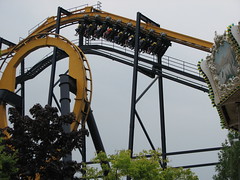 in the front row, ascending the lift; we reach the crest and skirt down the pre-drop before sharply twisting around and down. The tight twisting is quite cool, haven’t quite had anything like that on a B&M coaster in a while, but I’m also struck by how short this drop is, pulling up what looks like twenty feet above ground-level when it’s already not much more than 100ft. tall. The first loop is tight and intense, but it also seems to just blow through it really fast rather than provide the dizzyingly quick fore-and-aft rotational forces I was expecting. What that means is, picture yourself doing a front-flip on a bungee trampoline: flipping around your axis in one second will feel much more intense than if it takes three, even though there’s technically no added g-forces involved between either scenarios.
in the front row, ascending the lift; we reach the crest and skirt down the pre-drop before sharply twisting around and down. The tight twisting is quite cool, haven’t quite had anything like that on a B&M coaster in a while, but I’m also struck by how short this drop is, pulling up what looks like twenty feet above ground-level when it’s already not much more than 100ft. tall. The first loop is tight and intense, but it also seems to just blow through it really fast rather than provide the dizzyingly quick fore-and-aft rotational forces I was expecting. What that means is, picture yourself doing a front-flip on a bungee trampoline: flipping around your axis in one second will feel much more intense than if it takes three, even though there’s technically no added g-forces involved between either scenarios.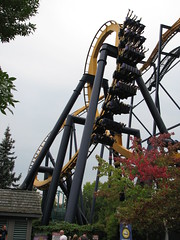
We pull up, into the zero-g roll (this was the first ever built). Again, in terms of timing it’s very quick, but I still seem to be missing the tight rotational g-forces. The rolling movement is much more sudden on this than on later versions where they would lead into it more on the incline. There’s also a bit of a ‘snap’ to the roll right at the inverting point, adding a bit extra unpredictability and intensity. Wasting no time, we’re diving back down to set up vertical loop number two, basically a carbon copy of the first and provides not much in the way of new sensations, but creates a nice, all straight-forward loop/roll/loop progression that constitutes the first half of the experience before it switches into the turn-based second half.
We slide hard around an upward left helix diminishes in force. There’s no midcourse brake run on the ride, but in some ways it still nearly feels like it because the high above the ground transition from left to right curve acts as half a placeholder. It’s alright though,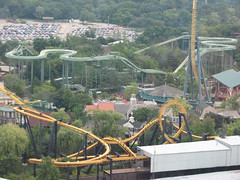 because this is one of the best places on the ride to appreciate the inverted set-up (particularly important if the year is 1992) and we get a good build-up as we dive to the right, almost like a second first drop, into the first flat-spin. We tightly whip around to the right without losing momentum before diving into a trench and continuing up into the second corkscrewing flat-spin. This combo of inversion/turn/inversion neatly mirrors the first loop/roll/loop progression that was on the opposite side of the high turn transition midpoint, and is also easily the most nimble the train gets. The final left turn starts out with some vigor but finishes weak as a denouement of sorts so the brake run that comes less than 40 seconds after cresting the lift doesn’t feel so unexpected.
because this is one of the best places on the ride to appreciate the inverted set-up (particularly important if the year is 1992) and we get a good build-up as we dive to the right, almost like a second first drop, into the first flat-spin. We tightly whip around to the right without losing momentum before diving into a trench and continuing up into the second corkscrewing flat-spin. This combo of inversion/turn/inversion neatly mirrors the first loop/roll/loop progression that was on the opposite side of the high turn transition midpoint, and is also easily the most nimble the train gets. The final left turn starts out with some vigor but finishes weak as a denouement of sorts so the brake run that comes less than 40 seconds after cresting the lift doesn’t feel so unexpected.
However, at the end of each of these rides, my right brain had to make a few concessions to my left brain; that while the quick timing between elements is there, by itself that doesn’t accomplish as much as I wish it could. I was hard-pressed to feel much extra rotational intensity from the extra-small elements, they were simply that: extra small. In many ways the ride reminds me perfectly of a mini-Raptor, with similar element sequencing and progression, just smaller, slower and over quicker. That’s hardly a bad thing, as Batman is still a great ride. It’s just I couldn’t find anything in its smallness to elevate it above the larger counterparts such as Raptor, it’s only a lesser brother to those rides.
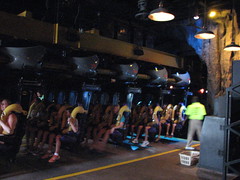 Now, I’m not going to declare anything definitive just yet, because my experiences came mostly from morning rides on a cool day, so the fact that the ride paced even comparably to Raptor is quite amazing. I’ve heard reports from people about how their local Batman ride used to go so fast on a hot summer night it looked physically dangerous from off-ride. I didn’t get those rides, so I can’t comment, but as long as someone qualifies that they did get to experience it when it was running that fast I wouldn’t have a problem if they claim it one of B&M’s best.
Now, I’m not going to declare anything definitive just yet, because my experiences came mostly from morning rides on a cool day, so the fact that the ride paced even comparably to Raptor is quite amazing. I’ve heard reports from people about how their local Batman ride used to go so fast on a hot summer night it looked physically dangerous from off-ride. I didn’t get those rides, so I can’t comment, but as long as someone qualifies that they did get to experience it when it was running that fast I wouldn’t have a problem if they claim it one of B&M’s best.
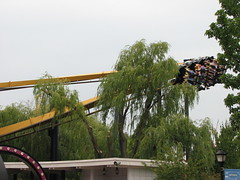 An added feature that I really liked about Six Flags Great America’s version is in the second half there were some extremely close calls with nearby trees and shrubs. Particularly on the descent down into the first corkscrew and immediately after the second on the final turn, the plant life nearly completely enfolds the trains on all sides, not only heightening the sense of speed but just making for an astonishing visual effect. Someone tall enough might even be able to kick some of the branches if they really reach for it. I don’t believe any other Batman layout has anything quite as confrontational; combined with the more natural setting that fits with the park, I think this first Batman probably is the best of all the versions ever manufactured since it’s debut.
An added feature that I really liked about Six Flags Great America’s version is in the second half there were some extremely close calls with nearby trees and shrubs. Particularly on the descent down into the first corkscrew and immediately after the second on the final turn, the plant life nearly completely enfolds the trains on all sides, not only heightening the sense of speed but just making for an astonishing visual effect. Someone tall enough might even be able to kick some of the branches if they really reach for it. I don’t believe any other Batman layout has anything quite as confrontational; combined with the more natural setting that fits with the park, I think this first Batman probably is the best of all the versions ever manufactured since it’s debut.
Superman: Ultimate Flight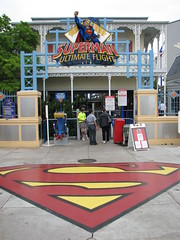
The park’s other inverted superhero themed coaster in many ways recalls its predecessor while in other ways offering the completely opposite experience. Batman is gritty and intense and based on quick variations in the layout, while Superman is graceful and slower paced, based on creating a singular flight sensation, and quite honestly it’s all a tad boring. It’s probably no surprise then that most enthusiasts (myself included) would take Batman over Superman any day of the week. That said there is more to justify the “Superman Experience” than I originally would have admitted, but what’s there still isn’t quite enough to justify any two-hour waits. I speak from experience, as the longest I ever waited for a roller coaster was this ride back in 2005 at nearly three and a half hours (there might have been longer lines in Millennium Force’s opening year but I can’t recall the specifics).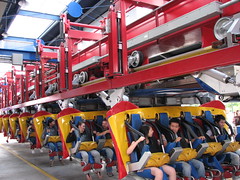
Also, Superman nearly justifies the expense of the Flash Pass all by itself. The queue is pretty much always the longest in the park, and the ride is the lowest capacity in the park except for the wild mice and maybe the Whizzer, although Superman is probably tied for popularity with Raging Bull so it’s a much larger draw. The merge point is right up in the station, so you can skip by a couple hours’ long wait in about a minute (minus the time waiting for your reservation time, however, but I’m fairly confident the actual queue length was longer than the 50 minutes our Flash Pass made us wait before boarding).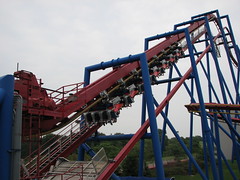
The flying experience really transforms the ride experience in more ways than one might at first anticipate. Pretty much every g-force you feel is redirected by 90 degrees, creating new directional forces we rarely if ever get to experience on a coaster, i.e. forward and backward forces are normally only felt on launches and brake runs; maybe spinning coasters. In none of those situations are the g-forces derived from gravitational conflicts either, giving a unique vocabulary to the styles of sensations on this coaster.
On the other hand I’ve still not been entirely sold on the ‘flying’ as a valid one. The main reason is that when we imagine what it would feel like to free-fly, zero-gravity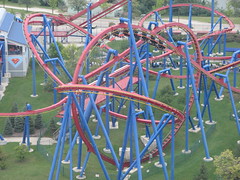 is generally assumed. That’s obviously not possible to sustain, so with the constant pull of gravity experienced that fairly well kills any real flying sensation, and that’s not including the restrictive restraints in the equation. Actually they are quite comfortable, but the fact is resting on your chest is not a very natural way to ride the coaster.
is generally assumed. That’s obviously not possible to sustain, so with the constant pull of gravity experienced that fairly well kills any real flying sensation, and that’s not including the restrictive restraints in the equation. Actually they are quite comfortable, but the fact is resting on your chest is not a very natural way to ride the coaster.
Then there’s the layout. Maybe it’s just me but if I could fly like Superman, I wouldn’t zig-zag over the same cleared field, I’d go places, over and under things, stuff like that. Every seat has an unrestricted view, and yet the park doesn’t capitalize on this at all, the uniform mowed lawn it’s built on only broken up by the same blue supports and the occasional queue line that everyone wonders if someone will throw up on them as they pass overhead.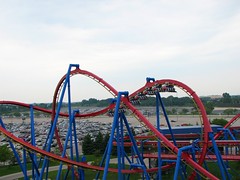
Also, in terms of progression, it’s rather awkward. The initial pretzel loop easily stands alone as a completely unique defining moment of the ride. The dynamics are unlike anything else, so when it comes right at the beginning of the layout it makes the rest of the coaster look boring by contrast. Airtime at the top, strong positives at the bottom (and remember these are all skewed by 90 degress so it’s a particularly wacky brand of airtime as it presses forward on your chest instead of up from underneath), plus the rapidly changing orientation to the ground that has us in a kamikaze dive upside down… it’s a great element, probably the most impressive single maneuver inside Great America’s gates.
 After that, layout, elements, pacing and progression all get shoved out the door in favor of a somewhat idyllic series of turns that don’t accomplish anything other than give a unified sensation of flying for several seconds.
After that, layout, elements, pacing and progression all get shoved out the door in favor of a somewhat idyllic series of turns that don’t accomplish anything other than give a unified sensation of flying for several seconds.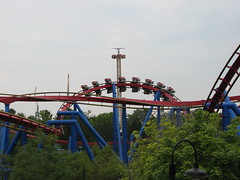 From a designer’s perspective, this track is pretty simple; I was looking at it from the station and realized most of the curves were based on simple geometric shapes and parabolic contours, nothing more advanced or intricate, with very long transitions. This section of the ride is over rather quickly as well, only about 22 seconds before the free-flight is over and we’re wrapping it up with the final inline roll into the brakes.
From a designer’s perspective, this track is pretty simple; I was looking at it from the station and realized most of the curves were based on simple geometric shapes and parabolic contours, nothing more advanced or intricate, with very long transitions. This section of the ride is over rather quickly as well, only about 22 seconds before the free-flight is over and we’re wrapping it up with the final inline roll into the brakes.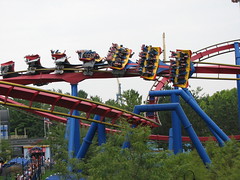
By the way, here’s an interesting debate I’m not sure I’ve ever seen had: does this final roll count as an inversion? By most accounts, yes, the track clearly rotates a complete 360 degrees. But what about from the rider’s perspective? They’re never held heels over head, their body length is always kept parallel to the ground, it just rotates around the front axis. Something fundamental about the nature of an ‘inversion’ seems to be denied with that. Yet it also would seem absurd to not call it an inversion, when the track is shaped nearly identical to other heartline rolls and in-line twists on standard, upright coasters, so why should those elemental properties change just when a particular train design is on them instead? Food for thought…
Iron Wolf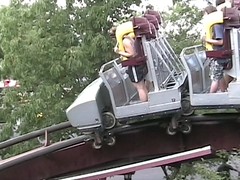
This was my favorite ride back in 2005. I suspect its unpopularity with the rest of the park guests (resulting in by far the shortest lines of the day) had something to do with it. But I also liked the layout of the coaster much more, and I never had any problems with roughness or head banging. It’s a tight, curved based layout that’s deceptively longer than it looks, and despite being a compact B&M coaster, it’s old enough that the trees around it have grown in really well and almost feels like a terrain coasters at times in the second half. While some people saw stand-up trains as a gimmick that rightfully needed to die before the turn of the millennium, I personally feel that they add a considerable amount to the ride experience, not that I’d like many more coasters to have them.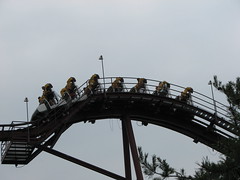 The body is much more vulnerable to g-forces making the ride more intense, and stretching our center of gravity up higher and affected by a longer span produces some interesting dynamics not experienced on sit-down coasters; as you go around a loop or over a drop on one of these things, recall that concept of torque from your high school physics class…
The body is much more vulnerable to g-forces making the ride more intense, and stretching our center of gravity up higher and affected by a longer span produces some interesting dynamics not experienced on sit-down coasters; as you go around a loop or over a drop on one of these things, recall that concept of torque from your high school physics class…
There’s also the roughness that a lot of people take issue with. I hear this about a lot of coasters, and I don’t understand much of any of it. When I hear people flaming a coaster in online message boards about how it cracked their spine in two and caused cranial hemorrhaging, and then I ride it and don’t have any problems whatsoever, I have been led to believe one of three conclusions:
1): That I am very lucky that I always get to ride rough coasters on their one ‘good’ day out of the year.
2): That most enthusiast’s skeletal structures are made out of Crispix.
3): That I am a masochist without realizing it.
While generally I like to believe hypothesis #2, after my five rides in a row on Iron Wolf that day (yes, in a row…) and being generally pulverized by the restraints and bad shuffling in the wheel assemblies on each and every cycle, I might have to consider #3 more carefully in the future.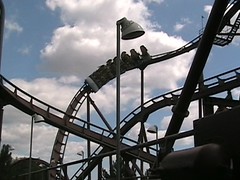
It wasn’t this rough back in 2005, which is a shame because the added roughness did diminish my enjoyment of the ride considerably. It was worst on the first drop, some of the curving dives in the first half, and the corkscrew, and generally much stronger in the back rows and on the edges; my one ride in the front and center row was by far the smoothest. Yet as I confessed, I still went around and did it four more times throughout the day knowing full well what I was in store for.
Maybe it was just that I knew how to brace for it properly, so as I was subjected to all the jostling I was able to avoid taking any ‘fatal blows’, allowing me to climb off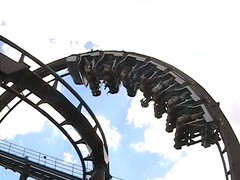 it in perfect condition but weary of all the work I had to put in to stay that way, which is a better adrenaline rush and scare factor than all the uber-controlled coasters that try to feign intimidation, i.e. Top Thrill Dragster and the like.
it in perfect condition but weary of all the work I had to put in to stay that way, which is a better adrenaline rush and scare factor than all the uber-controlled coasters that try to feign intimidation, i.e. Top Thrill Dragster and the like.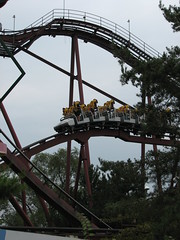
And it’s still a good layout, altering between slower, more graceful moments I could let my guard down, and faster, more intense moments I had to physically and psychologically prepare for lest I get the crap beat out of me. In terms of layout, it’s probably my favorite of all the early B&M stand-ups, much more convoluted and with hidden layers of twists and turns in the finale, overall a stronger emphasis on multitudes of direction changes and a complex layout than later designs that started splitting the coasters up into fewer ‘big moment’ elements. Plus, as I mentioned, the surroundings add a lot too, with plenty of trees that perfectly fit the ride theme, a sort of symbiotic mix between the rustic and the industrial. Although I was still relieved whenever we finally got to the brake run.
Iron Wolf probably has its days numbered, especially with the rumors that Six Flags Kentucky Kingdom’s Chang will be relocated here in 2011. That’s appropriate, since the ride is a bit too small for the park these days, and that back corner needs some revitalization as hardly anyone makes it back there anymore. Besides, I’d hate to see the stand-up concept leave the park after all this time, so it’s a fitting upgrade. And Iron Wolf should be relocated to another park in the chain, since while 1990 might seem ancient for a B&M coaster, it’s still quite young compared to other steel coasters that have been relocated, and would make a great fit at a place like Six Flags Mexico, Six Flags America or some other park that needs a new steel coaster but doesn’t have a complete budget for one.
Raging Bull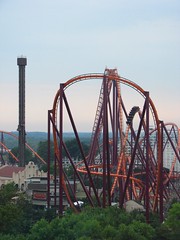
I’m not sure which of Great America’s B&M Quartet is my personal favorite but I think Raging Bull is easily their most ambitious. Unfortunately, that infers that it also must be the one with the most holding it back from the greatness it could be. In this case, quite literally “holding it back”. Two words:
Trim.
Brake.
Ah, I’m foreshadowing too much. First, what is there to like about Raging Bull? Plenty. For starters (and this may be an unpopular opinion) but I personally feel that, at least theoretically, Raging Bull has one of the best layouts ever seen on a B&M speed coaster, perhaps tied only with Apollo’s Chariot. I see a lot more of the attention to layout detailing found on their older rides than all the post-Nitro stuff where it was just about building the same damn camelbacks and turns over and over again.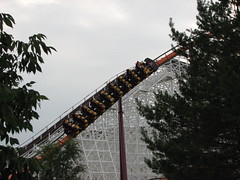 It seems ever since Magnum started the trend, every hyper coaster built has to be entirely airtime based, and built around some variation of an out-and-back layout (if not directly in the plotting, then at least in the spirit of having the hills being the showcase elements with turns randomly inserted as completely disparate elements from the hills). True hyper-twisters are extremely hard to come by; Kings Dominion’s Intimidator 305 may be the closest yet to that ideal, and the Giovanola hypers are probably the next closest thing (in the U.S., at least). Raging Bull was clearly the inspiration for those two, but blends more of the traditional airtime/straight maneuvers with a twistery layout, and in my opinion if it would just run like it’s supposed to it would strike a perfect balance between the two.
It seems ever since Magnum started the trend, every hyper coaster built has to be entirely airtime based, and built around some variation of an out-and-back layout (if not directly in the plotting, then at least in the spirit of having the hills being the showcase elements with turns randomly inserted as completely disparate elements from the hills). True hyper-twisters are extremely hard to come by; Kings Dominion’s Intimidator 305 may be the closest yet to that ideal, and the Giovanola hypers are probably the next closest thing (in the U.S., at least). Raging Bull was clearly the inspiration for those two, but blends more of the traditional airtime/straight maneuvers with a twistery layout, and in my opinion if it would just run like it’s supposed to it would strike a perfect balance between the two.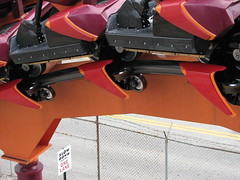
Like every other B&M speed coaster, the seating and restraints are the most comfortable and unrestrictive ever devised for a modern steel coaster, the tipped back seats lifting feet off the floor helping to establish a tremendous sensation of freedom while on the ride. The station also beats other similar rides with similar themes (*cough*kingsisland*cough*), actually recalling a southwestern mission church rather than simply being 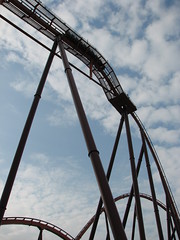 one of the contractor’s prefab steel sheds with wooden paneling nailed in at crooked angles. And from off-ride, Raging Bull actually does some justice to surrounding area; an intimidating presence in the park, to be sure, but it doesn’t dominate the midways and distract attention from the other rides and themed locales. It’s there just a few feet off to the side, impossibly tall and larger than life (probably helped by the fact that you can’t see the footers) but quiet enough that the full impact of its presence doesn’t hit you unless you look it straight in the eyes. The orange track with magenta supports and jet black trains are an original paint combination, not gaudy like the trademark Cedar Fair bright red/yellow, but still attention grabbing, highlighting both the Southwestern inspiration and the technological sheen at the same time. The three, 36 passenger trains cycle through the station with considerable speed, making Raging Bull perhaps the only coaster truly suitable to handle the Great American sized crowds.
one of the contractor’s prefab steel sheds with wooden paneling nailed in at crooked angles. And from off-ride, Raging Bull actually does some justice to surrounding area; an intimidating presence in the park, to be sure, but it doesn’t dominate the midways and distract attention from the other rides and themed locales. It’s there just a few feet off to the side, impossibly tall and larger than life (probably helped by the fact that you can’t see the footers) but quiet enough that the full impact of its presence doesn’t hit you unless you look it straight in the eyes. The orange track with magenta supports and jet black trains are an original paint combination, not gaudy like the trademark Cedar Fair bright red/yellow, but still attention grabbing, highlighting both the Southwestern inspiration and the technological sheen at the same time. The three, 36 passenger trains cycle through the station with considerable speed, making Raging Bull perhaps the only coaster truly suitable to handle the Great American sized crowds.
 The first drop is probably my favorite on any B&M speed coaster. The pre-drop section gives a moment to savor the heights and the slight increase in speed off the lift gives the ride a moment to ‘get into gear’ before flooring it with the first drop, if you understand what I’m saying. Then there’s the crest into the 208 ft. drop itself, because of the faster speed from the pre-drop and the fact it has a sharper pull over due to the absence of the lift mechanisms really jolts one out of their seat if they’re sitting in the back, and the front’s not bad either. This isn’t a quick moment of sharp ejector air either, it’s sustained as mild-ejector for the couple seconds it takes to reach the pullout at the bottom, something very few first drops are able to accomplish. Then there’s the underground tunnel at the bottom, which is rare for a B&M (especially their speed coasters) and really helps highlight the sense of speed at the bottom, which can sometimes be a hard thing to judge when the trains run so smoothly. I could probably rate this first drop as one of my top ten favorites. Unfortunately this is probably the best the ride ever has going for it, so enjoy this element while it lasts.
The first drop is probably my favorite on any B&M speed coaster. The pre-drop section gives a moment to savor the heights and the slight increase in speed off the lift gives the ride a moment to ‘get into gear’ before flooring it with the first drop, if you understand what I’m saying. Then there’s the crest into the 208 ft. drop itself, because of the faster speed from the pre-drop and the fact it has a sharper pull over due to the absence of the lift mechanisms really jolts one out of their seat if they’re sitting in the back, and the front’s not bad either. This isn’t a quick moment of sharp ejector air either, it’s sustained as mild-ejector for the couple seconds it takes to reach the pullout at the bottom, something very few first drops are able to accomplish. Then there’s the underground tunnel at the bottom, which is rare for a B&M (especially their speed coasters) and really helps highlight the sense of speed at the bottom, which can sometimes be a hard thing to judge when the trains run so smoothly. I could probably rate this first drop as one of my top ten favorites. Unfortunately this is probably the best the ride ever has going for it, so enjoy this element while it lasts.
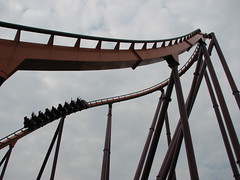 Actually the next turn is a nice maneuver as well. Some people dislike it because it’s rather drawn out and not particularly overbanked like the hammerhead maneuvers on Nitro or Diamondback, but I like the shaping to it, how it’s made of three parts, the twisting crest into, the flat turn at top that pushes the positives a bit, then free-falling back down with another rotational twist out of the curve. It all gives a better sense of space and changing directionality than those other turnarounds, even if it is rather slow paced and not particularly aggressive.
Actually the next turn is a nice maneuver as well. Some people dislike it because it’s rather drawn out and not particularly overbanked like the hammerhead maneuvers on Nitro or Diamondback, but I like the shaping to it, how it’s made of three parts, the twisting crest into, the flat turn at top that pushes the positives a bit, then free-falling back down with another rotational twist out of the curve. It all gives a better sense of space and changing directionality than those other turnarounds, even if it is rather slow paced and not particularly aggressive.
We surge back up, crossing over the first drop into what should be the ride’s really big airtime centerpiece moment. Instead, we are unexpectedly thrown forward  into our restraints as those nefarious trim brakes clobber our train’s forward momentum. We spend the rest of the hill sitting firmly in our seats, trying to pretend the 0.5 g-forces felt from the descending acceleration on the way down is actual 0-g airtime. It gets worse from here. The next hill, a steeply banked camelback hill, has the potential to be quite awesome, perhaps one of the most daring moments on a B&M speed coaster. There’s not too much inward curvature so in theory it could sustain close to 0 g’s like a regular camelback, only we’d be tipped completely on our sides, creating a rather bizarre disjuncture between sight (extreme) and sensation (relaxed). However, because we’re going so much slower than the design intended, I found myself in a very uncomfortable
into our restraints as those nefarious trim brakes clobber our train’s forward momentum. We spend the rest of the hill sitting firmly in our seats, trying to pretend the 0.5 g-forces felt from the descending acceleration on the way down is actual 0-g airtime. It gets worse from here. The next hill, a steeply banked camelback hill, has the potential to be quite awesome, perhaps one of the most daring moments on a B&M speed coaster. There’s not too much inward curvature so in theory it could sustain close to 0 g’s like a regular camelback, only we’d be tipped completely on our sides, creating a rather bizarre disjuncture between sight (extreme) and sensation (relaxed). However, because we’re going so much slower than the design intended, I found myself in a very uncomfortable position as everyone in the train was sliding in their seats down to the left, ironically creating probably the most extreme laterals ever experienced on a B&M speed coaster.
position as everyone in the train was sliding in their seats down to the left, ironically creating probably the most extreme laterals ever experienced on a B&M speed coaster.
This is a problem. Why is that trim brake on so hard? The two reasons normally associated for their use (less stress on track/train and controlling the experience for riders) actually have the reverse effects in this case. For riders, both the sudden jolt forward into the seats from the sudden slowdown in speed, and this next hill which puts stress on an awkward position on the left side of the waist from the way the seats are designed. And as far as maintenance is concerned, I can only imagine the frictional wear down on the braking and undercarriage components costs them something over time. Plus I read recently that the train vallied in the figure-eight during a test run on a rather cool day, and fishing out a vallied train, especially a heavy one like Raging Bull’s, I can’t imagine is anything the maintenance department enjoys having called in.
Anyway, so next we pull back up into the other bookending turnaround, this one similar to the first but tighter and crossing over itself on the way out. Some people might complain that the layout wastes too much on these unnecessary turning maneuvers (I recall I had a similar complaint for Diamondback) but in the context of the ride I appreciate that these multiple changes in direction keep the layout feeling longer and more involved than if it were kept much simpler. I think of Raging Bull as having an actual layout, rather than a plot of land that a couple camelback hills can be fit on before they have to turn around after just one or two.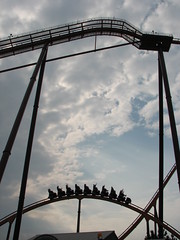
We climb up into the midcourse brake, which mercifully was very light, letting this final section of the ride still have a bit of a pulse. Airtime for those of you in the back (the back is easily the best place to ride on this coaster if you haven’t guessed already)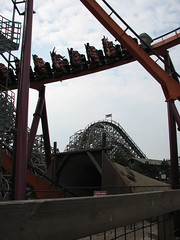 off the midcourse dive, and then again on the subsequent bunny hop. We make our way around a partial uphill helix, appearing for a moment to run out of momentum, but then are met with a dive all the way down to ground level that causes the speedometer to kick up again.
off the midcourse dive, and then again on the subsequent bunny hop. We make our way around a partial uphill helix, appearing for a moment to run out of momentum, but then are met with a dive all the way down to ground level that causes the speedometer to kick up again.
Again, some people don’t like this last part but I do. Raging Bull ends with a figure-eight finale, mixed with a few slight rises and minor drops, but for the most part the pace is kept more consistently fast here, always charging into each turn unlike the contrasting dynamics between fast and stalling out that normally come with the bunny hill string as a finale. And this is actually something of a finale. The other speed coasters just end with more of the same, maybe some individual drop or bunny hill that feels a bit more definitive than the rest, but here with the continuous pacing that also contrasts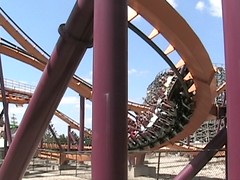 with the rest of the ride experience I actually get something out of this finale, even if it’s not airtime or other sorts of g-forces. I do wish they could have been a bit more daring with some of the transitions here, however, perhaps to be made more like Mantis’ extremely tight figure-eight finale. Regardless it’s a unique close to a unique hyper coaster.
with the rest of the ride experience I actually get something out of this finale, even if it’s not airtime or other sorts of g-forces. I do wish they could have been a bit more daring with some of the transitions here, however, perhaps to be made more like Mantis’ extremely tight figure-eight finale. Regardless it’s a unique close to a unique hyper coaster.
I sincerely believe that if they would just turn off the trim brakes and let the damn thing actually carry some g-forces (at least that aren’t unintentional), Raging Bull could be one of B&M’s best efforts. As it rides right now, however, I’m just too… frustrated… whenever I ride it, always keenly aware of how slow every element is taken and how the ride at nearly any given moment could and should be better than it is. Maybe they’re just a seasonal thing and people out there still on a regular basis get trimless rides that show the potential this ride really has. That’s the only reason I can think of for this ride’s #14 placement in the most recent Golden Ticket Awards, outranking even rides like Maverick (well, besides the fact that a cumulative point system will alway show bias towards more well known coasters at popular parks).
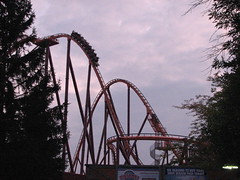 Between the four of these rides, I honestly would have a hard time choosing a favorite after this visit. I could make a case for each Raging Bull, Iron Wolf and Batman… sorry to any Superman fans, but that one’s very close behind the other three. None of them strike me as being clearly ‘great’ coasters, although like I said Raging Bull clearly has the largest potential. Iron Wolf and Batman are relatively more successful, but while each makes the most with what they’re given, neither was given all too much, both being prototype models from early in B&M’s career. In fact I don’t think I could declare any of these to be the best ride in the park. To find out which ride I would bestow that honor to, please read the Classic Steel & Wood review below… the result is almost guaranteed to surprise you.
Between the four of these rides, I honestly would have a hard time choosing a favorite after this visit. I could make a case for each Raging Bull, Iron Wolf and Batman… sorry to any Superman fans, but that one’s very close behind the other three. None of them strike me as being clearly ‘great’ coasters, although like I said Raging Bull clearly has the largest potential. Iron Wolf and Batman are relatively more successful, but while each makes the most with what they’re given, neither was given all too much, both being prototype models from early in B&M’s career. In fact I don’t think I could declare any of these to be the best ride in the park. To find out which ride I would bestow that honor to, please read the Classic Steel & Wood review below… the result is almost guaranteed to surprise you.
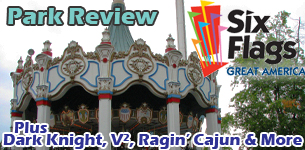
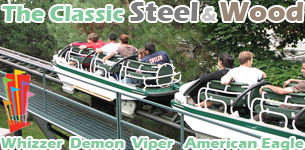

 and spirals over and over again. It seems ever since Magnum started the trend, every hyper coaster has to be entirely airtime based, and designed around some variation of an out-and-back layout (if not directly in the plotting, then at least in the spirit of having the hills being the showcase elements with turns randomly inserted to turn it back to the station). True hyper-twisters are extremely hard to come by; Kings Dominion’s Intimidator 305 may be the closest yet to that ideal, and the two Giovanola hypers are possibly the next closest thing (in the U.S., at least). Raging Bull seems to be the inspiration for those two, but it blends more traditional airtime and straight maneuvers within an overall twistery layout, and in my opinion if it would just run like it’s supposed to it would strike a perfect balance between the two.
and spirals over and over again. It seems ever since Magnum started the trend, every hyper coaster has to be entirely airtime based, and designed around some variation of an out-and-back layout (if not directly in the plotting, then at least in the spirit of having the hills being the showcase elements with turns randomly inserted to turn it back to the station). True hyper-twisters are extremely hard to come by; Kings Dominion’s Intimidator 305 may be the closest yet to that ideal, and the two Giovanola hypers are possibly the next closest thing (in the U.S., at least). Raging Bull seems to be the inspiration for those two, but it blends more traditional airtime and straight maneuvers within an overall twistery layout, and in my opinion if it would just run like it’s supposed to it would strike a perfect balance between the two.
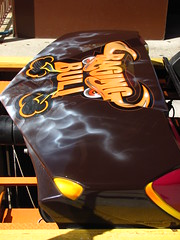 to establish a tremendous sensation of freedom while on the ride. The station also beats other similar rides with similar themes (*cough*kingsisland*cough*), actually recalling a southwestern mission church rather than simply being one of the contractor’s prefab steel sheds with wooden paneling nailed in at crooked angles. And from off-ride, Raging Bull actually does some justice to the surrounding area; an intimidating presence in the park,
to establish a tremendous sensation of freedom while on the ride. The station also beats other similar rides with similar themes (*cough*kingsisland*cough*), actually recalling a southwestern mission church rather than simply being one of the contractor’s prefab steel sheds with wooden paneling nailed in at crooked angles. And from off-ride, Raging Bull actually does some justice to the surrounding area; an intimidating presence in the park, to be sure, but it doesn’t dominate the midways and distract attention from the southwestern ambiance. It’s there just a few meters off to the side, impossibly tall and larger than life (probably helped by the fact that the footers are all hidden behind the themed environment’s western border, sprouting up from behind the horizon like a steel rainbow) but subdued enough that the its presence doesn’t overwhelm you unless you stare it dead in the eyes. The orange track with plum supports and jet black trains are an original paint combination, not gaudy like the trademark Cedar Fair bright red and yellow, but still attention grabbing, highlighting both the Southwestern inspiration and the technological sheen at the same time. The three, 36 passenger trains cycle through the station with considerable speed (a public countdown timer in the station helps ensure dispatches every minute or so), making Raging Bull perhaps the only coaster suited to handle the typically Great American sized crowds.
to be sure, but it doesn’t dominate the midways and distract attention from the southwestern ambiance. It’s there just a few meters off to the side, impossibly tall and larger than life (probably helped by the fact that the footers are all hidden behind the themed environment’s western border, sprouting up from behind the horizon like a steel rainbow) but subdued enough that the its presence doesn’t overwhelm you unless you stare it dead in the eyes. The orange track with plum supports and jet black trains are an original paint combination, not gaudy like the trademark Cedar Fair bright red and yellow, but still attention grabbing, highlighting both the Southwestern inspiration and the technological sheen at the same time. The three, 36 passenger trains cycle through the station with considerable speed (a public countdown timer in the station helps ensure dispatches every minute or so), making Raging Bull perhaps the only coaster suited to handle the typically Great American sized crowds.
 Actually the next turn is a nice maneuver as well. Some people dislike it because it’s rather drawn out and not particularly overbanked like the hammerhead maneuvers on Nitro or Diamondback, but I like the shaping to it, how it’s made of three parts, the twisting crest into, the flat pinched corner at top, then gracefully descending back down with another rotational twist out of the curve. It all gives a better sense of space and changing directionality than those other turnarounds, even if it is rather slow paced and not particularly aggressive.
Actually the next turn is a nice maneuver as well. Some people dislike it because it’s rather drawn out and not particularly overbanked like the hammerhead maneuvers on Nitro or Diamondback, but I like the shaping to it, how it’s made of three parts, the twisting crest into, the flat pinched corner at top, then gracefully descending back down with another rotational twist out of the curve. It all gives a better sense of space and changing directionality than those other turnarounds, even if it is rather slow paced and not particularly aggressive. as those nefarious trim brakes clobber our train’s kinetic energy. We spend the rest of the hill sitting firmly in our seats, trying to pretend the 0.5 g-forces felt from the descending acceleration on the way down is actual 0-g airtime. It gets worse from here. The next hill, a steeply banked camelback hill, should have been a very elegant yet askew maneuver. There’s not too much inward curvature so in theory it could sustain close to 0 g’s like a regular camelback, only we’d be tipped completely on our sides for several moments, creating a rather bizarre disjuncture between sight (abnormal) and sensation (relaxed). However, because we’re going so much slower than the design intended, I found myself in a very uncomfortable position as everyone in the train was sliding in their seats down to the left, ironically creating the most extreme laterals ever
as those nefarious trim brakes clobber our train’s kinetic energy. We spend the rest of the hill sitting firmly in our seats, trying to pretend the 0.5 g-forces felt from the descending acceleration on the way down is actual 0-g airtime. It gets worse from here. The next hill, a steeply banked camelback hill, should have been a very elegant yet askew maneuver. There’s not too much inward curvature so in theory it could sustain close to 0 g’s like a regular camelback, only we’d be tipped completely on our sides for several moments, creating a rather bizarre disjuncture between sight (abnormal) and sensation (relaxed). However, because we’re going so much slower than the design intended, I found myself in a very uncomfortable position as everyone in the train was sliding in their seats down to the left, ironically creating the most extreme laterals ever experienced on a B&M speed coaster. Maybe there’s something to like about this unintentionally forceful section, but it’s also an annoying reminder of how compromised the rest of the layout will be due to the reduced speed.
experienced on a B&M speed coaster. Maybe there’s something to like about this unintentionally forceful section, but it’s also an annoying reminder of how compromised the rest of the layout will be due to the reduced speed.
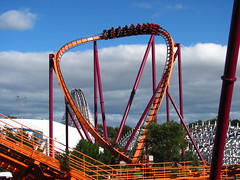 components costs them something over time. Plus, I read recently (back in 2009) that the train vallied in the figure eight during a test run on a rather cool day. Fishing out a vallied train, especially a heavy one like Raging Bull’s, I can’t imagine is anything the maintenance department enjoys having called in, and it seems probable that the trims bear part of the responsibility.
components costs them something over time. Plus, I read recently (back in 2009) that the train vallied in the figure eight during a test run on a rather cool day. Fishing out a vallied train, especially a heavy one like Raging Bull’s, I can’t imagine is anything the maintenance department enjoys having called in, and it seems probable that the trims bear part of the responsibility.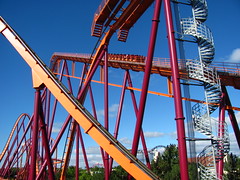 of the ride I appreciate that these multiple changes in direction keep the layout feeling longer and more involved than if it were kept much simpler. I think of Raging Bull as having a fully realized layout, rather than a plot of land that can fit a couple camelback hills before they have to turn around after just one or two.
of the ride I appreciate that these multiple changes in direction keep the layout feeling longer and more involved than if it were kept much simpler. I think of Raging Bull as having a fully realized layout, rather than a plot of land that can fit a couple camelback hills before they have to turn around after just one or two.

 part of the ride, signaling we’ve reached
part of the ride, signaling we’ve reached the coda and that the end must be near. However I wish the transitions could have been more daring, perhaps to be made more like Mantis’ extremely tight figure eight. Regardless it’s a unique close to a unique hyper coaster.
the coda and that the end must be near. However I wish the transitions could have been more daring, perhaps to be made more like Mantis’ extremely tight figure eight. Regardless it’s a unique close to a unique hyper coaster. actually produce some stronger g-forces (at least that aren’t unintentional), Raging Bull could be one of B&M’s best efforts. As it rides right now, I’m just too… frustrated… whenever I ride it, always keenly aware of how slow every element is taken and how the ride at nearly any given moment could and should be better than it presently is. Maybe people out there still on a regular basis get trimless rides that show the potential this ride really has. That’s the only reason I can think of for its continually high placement on the top twenty-five page of the Golden Ticket Awards… well, besides the fact that a cumulative point system will always show bias towards more well known coasters at popular parks.
actually produce some stronger g-forces (at least that aren’t unintentional), Raging Bull could be one of B&M’s best efforts. As it rides right now, I’m just too… frustrated… whenever I ride it, always keenly aware of how slow every element is taken and how the ride at nearly any given moment could and should be better than it presently is. Maybe people out there still on a regular basis get trimless rides that show the potential this ride really has. That’s the only reason I can think of for its continually high placement on the top twenty-five page of the Golden Ticket Awards… well, besides the fact that a cumulative point system will always show bias towards more well known coasters at popular parks.







































Comments